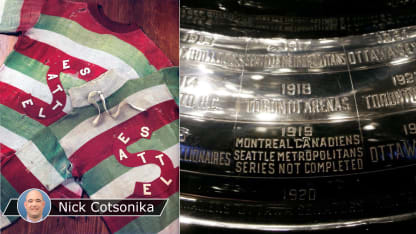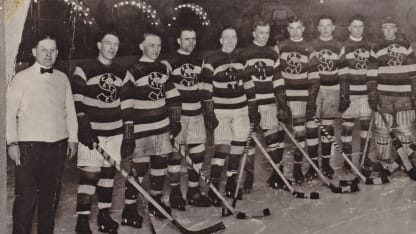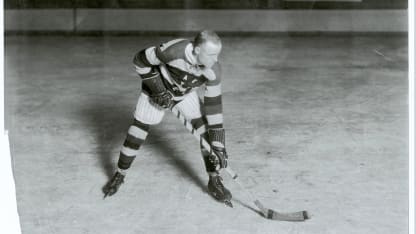Canadiens in Seattle to face Kraken 102 years after Cup battle in city
1919 series against Metropolitans was cancelled after fifth game due to Spanish flu epidemic

Wilson played for the Seattle Metropolitans of the Pacific Coast Hockey Association from 1916-19. Seattle became the first city in the United States to win the Stanley Cup when the Metropolitans defeated the Montreal Canadiens of the National Hockey Association in 1917, months before the Canadiens became a founding member of the NHL. The Metropolitans nearly defeated the Canadiens for the Cup again in 1919, but the "world series" or "World's Series," as the papers called it, was not completed because of the Spanish flu.
Each series was played entirely at Seattle Arena, one of the first facilities in the world with artificial ice, at Fifth Avenue and University Street. A plaque commemorates the spot in a plaza outside an office building about 1 1/2 miles from Climate Pledge Arena.
Now the Canadiens will return for a meaningful game for the first time in more than a century when they play the Seattle Kraken at Climate Pledge Arena on Tuesday (10 p.m. ET; ROOT-NW, TSN2, RDS, ESPN+, NHL LIVE), and they'll do it amid another pandemic, with fans wearing masks in the stands as they did in 1919. The oldest NHL team -- for which Wilson also played nine games in 1920-21, by the way -- will play its newest.
"Them coming back here a hundred years later, it really gives me goosebumps," said Dave Eskenazi, a Pacific Northwest sports aficionado and memorabilia collector, who loaned Wilson's skates to the preview center. "I have such vivid visions of the story of our early Seattle hockey roots. It almost seems like fiction."
The story of the Metropolitans, especially the chapters involving the Canadiens, has been inspiring hockey fans in Seattle for years but can reach a wider audience now because of the Kraken.
Paul Kim grew up playing hockey in Seoul, South Korea, and after his family moved to Seattle, he read a book on Seattle hockey history while learning English. He went on
to secure the rights
to the Metropolitans name and logo, an "S" with the letters "S-E-A-T-T-L-E" snaking through it.
To celebrate the centennials of big moments involving the Metropolitans, he helped create a throwback night with Seattle of the Western Hockey League, bring the Stanley Cup to Seattle twice and get that plaque installed at the old arena site.
Fans have worn Kim's maroon, green and cream
Metropolitans gear
to events ranging from the official NHL expansion announcement party Dec. 4, 2018, to the Kraken's inaugural home opener against the Vancouver Canucks on Saturday. Kim said he has spoken to the Kraken about the potential use of the Metropolitans name and logo, but they haven't reached a deal.
No doubt some will wear Metropolitans gear when the Kraken play the Canadiens.
"It is something that I dreamt of since I started my project or even before that," Kim said. "I had to save up money to start my business, and when I was saving up money, I was like, 'It would be so cool if one day it's going to happen,' because back then, nobody knew a hockey team was coming to Seattle."
* * * * *
The Metropolitans got their name from the Metropolitan Building Company, which built Seattle Arena, also known as Seattle Ice Arena, a brick building with a capacity of about 2,500. They joined the PCHA in 1915-16, when it was challenging the NHA for hockey supremacy and fighting for top players.
Seattle was stacked. The Metropolitans got five players from the Toronto Blueshirts of the NHA, who had won the Stanley Cup in 1914: Wilson, Ed Carpenter, Frank Foyston, Hap Holmes and Jack Walker. Foyston, Holmes and Walker would end up in the Hockey Hall of Fame.

© Hockey Hall of Fame
"Seattle fans didn't know it at the time, but this was one of the most potent lineups assembled in the early days of the game," Jeff Obermeyer wrote in "Emerald Ice: Hockey in Seattle from 1915 to 1975," one of his three books on Seattle hockey history.
When the defending Stanley Cup champion Canadiens trekked to Seattle for the 1917 series, they left the Cup in Montreal. They had five players who would end up in the Hockey Hall of Fame: Newsy Lalonde, Jack Laviolette, Didier Pitre, Tommy Smith and Georges Vezina.
"They didn't bring it because they didn't think they were going to lose it," said Kevin Ticen, author of the book, "When It Mattered Most: The Forgotten Story of America's First Stanley Cup Champions, and the War to End All Wars."
The teams had eight or nine players, and they played odd-numbered games by PCHA rules (seven men per side and forward passes allowed in the neutral zone, most notably) and even-numbered games by NHA rules (six men per side and no forward passes).
Montreal won the first game 8-4, despite the PCHA rules. Seattle swept the rest of the best-of-5 series, winning 6-1, 4-1 and 9-1, twice defeating the Canadiens under NHA rules.
"Historians who write of the rise and fall of Les Canadiens dynasty will record how this dashing band of Flying Frenchmen traveled 3,000 miles to find an adversary worthy of its steel and discovered a foe that outclassed it in every department of the great ice game," The Seattle Daily Times wrote.
In hindsight, the Montreal dynasty hadn't even risen yet. The Canadiens went on to win 23 of their 24 championships after that, and they own far more than any other team. But three months after the Metropolitans' victory, the Stanley Cup arrived in Seattle. In a sense, Seattle arrived as a big-league town.

© Hockey Hall of Fame
"It was so huge for the community to stick that feather in their cap," Ticen said.
No other U.S. team would win the Cup until the New York Rangers in 1928. Seattle would not win another major championship until 1979, when the Seattle SuperSonics won the NBA title. Game 4 of the 1979 NBA Finals between the Sonics and Washington Bullets was at Seattle Center Coliseum under the same roof that shelters Climate Pledge Arena today.
* * * * *
When fans arrive at Climate Pledge Arena on Tuesday, they will have to prove they have been vaccinated against the coronavirus by preregistering in an app and scanning a QR code at the gate. Everyone must be masked.
The last time the Canadiens visited, not counting an exhibition against the Seattle Totems of the former professional Western Hockey League in October 1961, this was the scene amid the Spanish flu pandemic:
"Spectators wore masks of sterilized cotton for protection from the germs," the late Royal Brougham, a legendary sportswriter who covered the series, wrote in a remembrance in the Post-Intelligencer on May 22, 1977. "In spite of warnings from the Health Department, the stands were packed. Armed guards at the entrance barred anyone without a mask."
The Metropolitans played without one of their best players, Bernie Morris, because he had been arrested for military draft evasion during World War I. His scoring touch was missed.
Seattle had a 2-1 series lead and a chance to clinch in the fourth game. Wilson put the puck past Vezina at the end of the first period, but the goal judge ruled time had expired. After four scoreless periods, the game ended in a 0-0 tie because it was played under NHL rules, which allowed for one overtime.
Montreal won the fifth game 4-3 in overtime, tying the series 2-2-1 and setting up a decisive sixth game.
But players had been collapsing from exhaustion, and now several were seriously ill. Hours before the sixth game was scheduled to start April 1, the series was cancelled and declared a tie. Canadiens defenseman Joe Hall died in Seattle on April 5.
"The flu hit players on both teams," Foyston said in the Post-Intelligencer on April 27, 1950. "We never knew who would be next or what our lineup would be until game time. There was an air of tragedy and fear hanging over the premises. It was awful."
Morris was acquitted and rejoined the Metropolitans before they played the original Ottawa Senators for the Cup on the road in 1920, but he wasn't in game shape and came off the bench as a substitute.
The weather was warm and the ice poor in Ottawa, which did not have artificial ice, and the Metropolitans fell behind in the series 2-1. The series shifted to Toronto, which did have artificial ice, and the Metropolitans tied the series 2-2 and took a 1-0 lead in the fifth game. But the Senators roared back and won 6-1.
The Metropolitans would never come so close again. They folded in 1924, and Seattle Arena was converted into a parking garage. The PCHA merged with the Western Canadian Hockey League, and that league folded in 1926, the year the Stanley Cup became the NHL's championship trophy.
The Seattle Arena building was demolished in 1963 and replaced by an office tower. In the Post-Intelligencer on April 12, 1963, Foyston said, "It won't be long before we get major league hockey here again."
Now, finally, here it is. After decades of minor league and junior hockey, Seattle has a team eligible to compete for the Stanley Cup once again, and an old foe to face in the Canadiens.

















